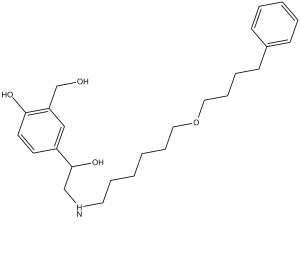This product is for research use only, not for human use. We do not sell to patients.

| Size | Price | Stock |
|---|---|---|
| 5mg | $75 | 3-6 Days |
| 10mg | $100 | 3-6 Days |
| 25mg | $195 | 3-6 Days |
| 50mg | $345 | 3-6 Days |
| 100mg | $550 | 3-6 Days |
| 250mg | $950 | 3-6 Days |
| 500mg | $1650 | 3-6 Days |
Cat #: V3390 CAS #: 18910-65-1 Purity ≥ 98%
Description: Salmeterol (AHR-3929; GR33343X; AHR3929; GR-33343G; Salmetedur, Serevent) is a potent and long-acting β2-adrenergic receptor agonist with anti-inflammatory effects (Ki of 1.5 nM for WT β2AR). It has been approved for use in the treatment of asthma symptoms and chronic obstructive pulmonary disease (COPD) symptoms. These symptoms include shortness of breath, wheezing, coughing and chest tightness. Salmeterol is also used to prevent breathing difficulties during exercise (exercise induced bronchospasm).
Publications Citing InvivoChem Products
Product Promise

- Physicochemical and Storage Information
- Protocol
- Related Biological Data
- Stock Solution Preparation
- Quality Control Documentation
| Molecular Weight (MW) | 415.57 |
|---|---|
| Molecular Formula | C25H37NO4 |
| CAS No. | 18910-65-1 |
| Storage | -20℃ for 3 years in powder form |
| -80℃ for 2 years in solvent | |
| Solubility In Vitro | DMSO: >100 mg/mL (165.6 mM) |
| Water: N/A | |
| Ethanol: N/A | |
| Synonyms | AHR 3929; GR-33343G; Salmetedur, Serevent; AHR-3929; GR33343X; AHR3929; Salmeterol xinafoate; GR-33343X xinafoate; GR 33343X xinafoate; Salmetedur, Serevent; GR 33343X; GR-33343X; SN408D |
| Protocol | In Vitro | In vitro activity: In a previoius study, it was found that salmeterol could reduce retinal Müller cell death through the inhibition of the phosphorylation of IRS-1(Ser307). In addition, the findings also suggest the importance of IRS-1 in beta-adrenergic receptor signaling in the prevention of cell death in retinal Müller cells. Kinase Assay: The cells are rinsed twice with ice-cold phosphate-buffered saline and mechanically detached in ice-cold buffer containing 10 mM Tris·HCl, pH 7.4, 5 mM EDTA, 10 μg/mL benzamidine, 10 μg/mL soybean trypsin inhibitor (type II-S), and 5 μg/mL leupeptin (lysis buffer). The lysate is centrifuged at 45,000 ×g for 10 min at 4°C. The pellet is rehomogenized in lysis buffer, with a Potter-type homogenizer, and stored at −80°C until use. The competition binding assays are performed in buffer containing 75 mM Tris·HCl, pH 7.4, 12.5 mM MgCl2, and 2 mM EDTA, using 1-5 μg of membrane protein, 50 pM 125I-CYP, and 0-100 μM unlabeled ligand in the presence of 100 μM GTP, for 60 min at 37°C. The binding reaction is terminated by dilution and rapid filtration through Whatman GF/C filters; the filters are washed three times with solution containing 25 mM Tris·HCl, pH 7.4, and 1 mM MgCl2. Nonspecific binding is determined in the presence of 5 μM (±)-propranolol. The radioactivity on the filters is counted with a γ-counter. Cell Assay: Salmeterol significantly inhibits production of pro-inflammatory mediators by RAW264.7 and THP-1 cells. Salmeterol downregulates PgLPS-mediated phosphorylation of the ERK1/2 and JNK but not p38 MAP kinases (MAP-K). Salmeterol also attenuates the activation of NF-κB via inhibition of nuclear translocation of p65-NFκB, the transcriptional activity of NF-κB and IκBα phosphorylation. Salmeterol shows very high selectivity for the WT β2AR (β1 Ki /β2 Ki ratio of approximately 1500) with Ki of 1.5±0.4 nM. Salmeterol prevents phosphorylation levels of IRS-1Ser307 induced by tumor necrosis factor-α. Salmeterol alone prevents cell death in retinal Müller cells (p<0.05 versus 25 mM glucose). Salmeterol in conbination with IRS-1 shRNA shows a significant increase in cell death compared to salmeterol alone. Moreover, salmeterol alone treatment significantly reduces cytochrome C levels, with the effect lessened when salmeterol is combined with IRS-1 shRNA. Salmeterol (100 μM) causes apoptosis of DCs, and can not affect the differentiation and maturation of DCs at 10 μM. Salmeterol (10 μM) decreases the mRNA and protein levels of pro-inflammatory cytokines in LPS-activated DCs and inhibits MAPK and NF-κB activation. |
|---|---|---|
| In Vivo | The OVA/LPS groups with salmeterol result in a significant decrease in the enhanced AHR in allergic mice in a dose-dependent manner. Salmeterol contends with asthma via regulating the inflammation of the airway of the mice. | |
| Animal model | Mice |
| Solvent volume to be added | Mass (the weight of a compound) | |||
|---|---|---|---|---|
| Mother liquor concentration | 1mg | 5mg | 10mg | 20mg |
| 1mM | 2.4063 mL | 12.0317 mL | 24.0633 mL | 48.1267 mL |
| 5mM | 0.4813 mL | 2.4063 mL | 4.8127 mL | 9.6253 mL |
| 10mM | 0.2406 mL | 1.2032 mL | 2.4063 mL | 4.8127 mL |
| 20mM | 0.1203 mL | 0.6016 mL | 1.2032 mL | 2.4063 mL |
This equation is commonly abbreviated as: C1 V1 = C2 V2
- (1) Please be sure that the solution is clear before the addition of next solvent. Dissolution methods like vortex, ultrasound or warming and heat may be used to aid dissolving.
- (2) Be sure to add the solvent(s) in order.




































